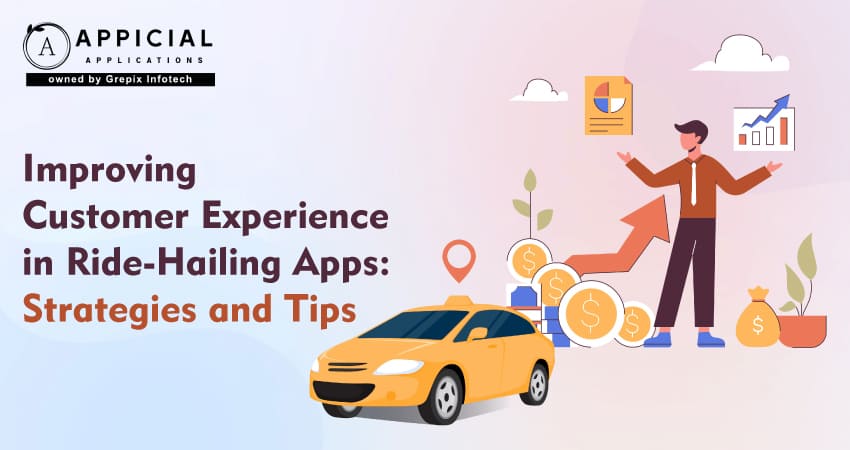
Improving Customer Experience in Ride-Hailing Apps: Strategies and Tips
In the rapidly evolving landscape of urban transportation, ride-hailing apps have revolutionized the way people commute. Uber, Lyft, and Grab have become household names by offering convenience, speed, and flexibility. However, as the market becomes increasingly saturated, customer experience (CX) has emerged as a critical differentiator. Improving CX is not just about providing a ride from point A to point B; it's about creating a seamless, enjoyable, and trustworthy journey for the user. This article explores strategies and tips for enhancing customer experience in ride-hailing apps.
Improving the customer experience in ride-hailing apps requires a blend of technology, human-centric design, and operational excellence. Key strategies include enhancing app usability with a user-friendly interface, integrating advanced technologies for service efficiency such as real-time tracking and AI, and focusing on driver support and safety measures. Personalizing user experiences through adaptable profiles and loyalty programs, offering seamless payment solutions, and maintaining robust communication channels are also vital. Continuous improvement through regular updates and customer feedback is crucial for evolving with user needs and preferences. These efforts ensure safety, convenience, and satisfaction, fostering brand loyalty and setting a foundation for sustained industry leadership.
Customer Experience in Ride-Hailing Apps Strategies
1 Understanding the Customer Journey
Before implementing any strategies, it's essential to understand the customer journey from start to finish. This includes:
- Discovery: How customers find out about your app.
- Onboarding: The initial experience when signing up.
- Booking: The process of requesting a ride.
- Ride Experience: Interaction with the driver and the ride itself.
- Post-Ride: Payment, feedback, and customer support.
By mapping out each touchpoint, you can identify pain points and areas for improvement.
2 Optimizing the User Interface (UI) and User Experience (UX)
A user-friendly app interface is crucial for retaining customers.
- Simplicity: The app should be easy to navigate, even for first-time users. Avoid clutter and focus on essential features.
- Speed: Ensure the app loads quickly and transactions are processed promptly.
- Personalization: Use data analytics to offer personalized suggestions, such as preferred routes or frequent destinations.
- Accessibility: Incorporate features that cater to users with disabilities, like voice commands or larger text options.
3 Enhancing Driver Performance
Drivers are the face of your company during the ride.
- Comprehensive Training: Provide training programs that focus on customer service, safety protocols, and app usage.
- Incentivization: Implement reward systems for drivers who receive high ratings or positive feedback.
- Real-Time Support: Offer drivers immediate assistance through in-app support to resolve issues quickly.
4 Ensuring Safety and Trust
Safety concerns can significantly impact customer trust.
- Background Checks: Conduct thorough background checks on all drivers.
- Real-Time Tracking: Allow users to share their ride status with friends or family.
- Emergency Features: Include an SOS button that connects users to emergency services.
- Transparent Ratings: Make driver ratings visible and allow customers to choose preferred drivers.
Also Read: How to Launch a Taxi App: From Idea to Execution in 6 Steps
5 Implementing Efficient Customer Support
Responsive customer support can turn a negative experience into a positive one.
- Multichannel Support: Offer support via chat, email, and phone.
- Quick Response Time: Aim to resolve issues promptly to maintain customer satisfaction.
- Feedback Mechanisms: Encourage users to provide feedback after each ride and act on it.
6 Leveraging Technology
Advanced technologies can enhance the overall experience.
- Artificial Intelligence (AI): Use AI for route optimization, predicting demand, and personalizing user experiences.
- Machine Learning: Analyze user behavior to improve services and predict trends.
- Augmented Reality (AR): Implement AR for features like pickup point identification.
- Blockchain: Explore blockchain for secure transactions and data privacy.
7Pricing Strategies
Transparent and fair pricing builds trust.
- Dynamic Pricing: While surge pricing can balance supply and demand, excessive charges deter users. Use algorithms that are fair and transparent.
- Discounts and Promotions: Offer loyalty programs, referral bonuses, and seasonal discounts to retain customers.
- Upfront Pricing: Show the estimated fare before the ride begins to avoid surprises.
8Expanding Service Offerings
Diversifying services can attract a broader customer base.
- Carpooling Options: Offer shared rides to reduce costs and environmental impact.
- Premium Services: Provide luxury vehicle options for users willing to pay more.
- Accessibility Services: Include options for users who need wheelchair-accessible vehicles.
- Additional Services: Explore services like food delivery or package transportation.
9Building a Community
Creating a sense of community can enhance customer loyalty.
- User Engagement: Host events, webinars, or forums where users can share experiences.
- Social Responsibility: Participate in community service or environmental initiatives.
- User-Generated Content: Encourage users to share stories or reviews on social media.
10Data Privacy and Security
Protecting user data is non-negotiable.
- Compliance: Adhere to data protection regulations like GDPR.
- Encryption: Use end-to-end encryption for data transmission.
- Transparency: Be clear about what data is collected and how it's used.
- User Control: Allow users to manage their data preferences easily.
11Continuous Improvement Through Analytics
Data analytics can provide insights into customer behavior and preferences.
- Key Performance Indicators (KPIs): Track user retention rate, average booking time, and customer satisfaction scores.
- A/B Testing: Test new features or changes on a small user group before a full rollout.
- Feedback Loops: Implement systems to collect and analyze customer feedback regularly.
12 Global Localization
Adapting to local cultures and regulations can enhance user experience in different regions.
- Language Support: Offer multiple language options within the app.
- Payment Methods: Include local payment options like mobile wallets or cash.
- Cultural Sensitivity: Be aware of local customs and norms, especially in marketing materials.
13Marketing and Communication
Effective communication can keep customers engaged and informed.
- Personalized Notifications: Send relevant updates, promotions, or reminders.
- Educational Content: Provide tips on using the app effectively or updates on new features.
- Crisis Communication: Communicate promptly during outages or issues to maintain trust.
14Marketing and Communication
Effective communication can keep customers engaged and informed.
- Personalized Notifications: Send relevant updates, promotions, or reminders.
- Educational Content: Provide tips on using the app effectively or updates on new features.
- Crisis Communication: Communicate promptly during outages or issues to maintain trust.
15Regulatory Compliance
Staying compliant with local laws enhances credibility.
- Licensing: Ensure all operations are fully licensed and meet legal requirements.
- Insurance: Provide adequate insurance coverage for drivers and passengers.
- Environmental Regulations: Comply with emissions standards and consider eco-friendly options.
16Emphasizing Sustainability
Environmental concerns are increasingly important to customers.
- Green Initiatives: Encourage the use of electric or hybrid vehicles.
- Carbon Offsetting: Offer options for users to offset their carbon footprint.
- Public Reporting: Share sustainability efforts and goals with users.
17Partnerships and Collaborations
Collaborations can enhance service offerings.
- Corporate Partnerships: Partner with businesses for corporate ride programs.
- Events and Venues: Collaborate with event organizers for seamless transportation solutions.
- Loyalty Programs: Team up with other companies to offer joint promotions.
18Feedback Integration
Actively integrating feedback shows customers that their opinions matter.
- Regular Surveys: Conduct in-app surveys to gauge customer satisfaction.
- Public Roadmaps: Share upcoming features or changes based on user feedback.
- Beta Testing: Allow users to test new features and provide input before official releases.
19Emergency Preparedness
Being prepared for emergencies enhances safety and reliability.
- Disaster Plans: Have protocols in place for natural disasters or major events.
- Driver Support: Provide resources and support for drivers during emergencies.
- User Communication: Keep users informed about service availability during crises.
Conclusion
The combination of technological innovation and user-centric design is best demonstrated by Appicial Applications, which dramatically improves the ride-hailing services' user experience. by concentrating on every facet of the service delivery process, from the design of the app's initial user interface to the point of final delivery.
We ensure interaction is geared towards safety, convenience, and overall satisfaction. The strategic application of advanced technologies such as AI and real-time tracking, combined with a strong emphasis on driver training and robust safety measures, positions Appicial as a leader in the transformation of urban mobility.
Further personalization of services, seamless payment solutions, and proactive customer support continue to set Appicial apart in a competitive market. By consistently investing in both technology and human capital, and by actively soliciting and incorporating user feedback, We are not just responding to current user needs but are also shaping the future of ride-hailing to offer an increasingly sophisticated and user-friendly service. This proactive approach not only enhances customer satisfaction but also fosters strong brand loyalty and positions for sustained growth and industry leadership.
Looking out to start your own venture like Uber? Try out our HireMe Uber Clone, the easiest way to kick-start your taxi business.




